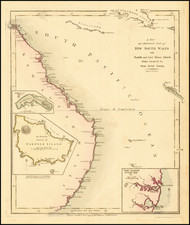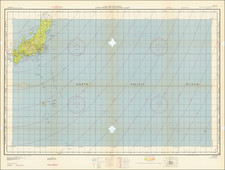6.5-Foot-Tall Battle-Used Map of Okinawa.
Impressive battlefield composite map of Okinawa, composed of numerous sections of SECRET Army Map Service sheets cut and pasted together to form one large image.
The map covers all of Okinawa, but for a small section of land in the southeast and northeast.
The map sheets show all of the potential landing beaches on the island, including the eventual main landing area (Beach Black, Green, etc.), and secondary landing sites away from the western beaches.
The sheets include a legend to the many defensive emplacements shown on the map:
- Coastal Defense Gun
- Coastal Defense Gun Emplacement (Empty)
- Single Mount Dual Purpose Gun (Gun Size 120MM-127MM)
- Single Mount Heavy AA (Gun Size Approx. 88MM)
- Heavy AA Emplacement (Empty) Dia. 16'-20'
- Single Mount Autom. AA (Gun Size 20MM - 40MM)
- Automatic AA Emplacement (Empty) Dia. 8'-6"
- Artillery Emplacement
- Artillery Emplacement (Empty)
- Pillbox
- Dual Purpose Gun Emplacement (Empty) Dia. 22'-36'
- Blockhouse
- Artillery Emplacement (Empty)
- Machine Gun Emplacement (13MM or Under)
- Radar
- Searchlight
- Earth Covered Structure or Buried Stores
- Unidentified Installation
- Empty Emplacement
- Trench
- Anti-Tank Trench
- Under Water Obstacle
- Radio Direction Finder
- Radio Tower
- Lighthouse
- Radio Station
Provenance
Carried at the Battle of Okinawa by an American soldier.
The United States Army and Marine Corps landed on Okinawa on April 1, 1945 as the specially-created 10th Army; the landing would be the largest amphibious assault in the Pacific Theater. The Battle of Okinawa, codenamed Operation Iceberg, lasted for 82 days after the landing, to June 1945 and claimed the lives of over 14,000 American and over 77,000 Japanese personnel. In addition, more than one hundred thousand Okinawans perished during and after the battle.
Okinawa was seen as the final island to overrun before the invasion of the Japanese homeland in Operation Downfall. This would be the closest American troops would get to the homeland prior to the dropping of the atomic bombs on Hiroshima and Nagasaki. Scholarship suggests that capture of the island was a motivating factor Japanese surrender, as it made a successful, though costly, invasion of the homeland inevitable.
The occupation of Okinawa would present unique challenges to the American army, as it represented the first time that the US would have to deal with a significant population that was (by most accounts) ethnically Japanese. Many Okinawans were initially very opposed to the Americans, and the Japanese army encouraged and forced mass suicides prior to the invasion. Despite this, the occupation was, for the most part harmonious. Okinawa remained under US military control until 1972, when it was returned to Japan.












![(Second World War - Battle of Moscow) [Red Army Operations at Solnechnogorsk, Moscow Oblast]](https://storage.googleapis.com/raremaps/img/small/83205.jpg)

![(Second World War - Battle of Okinawa) [Nine Reconnaissance Photographs of Naha Airfield, Okinawa]](https://storage.googleapis.com/raremaps/img/small/90452.jpg)

